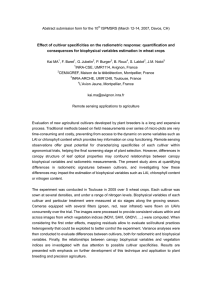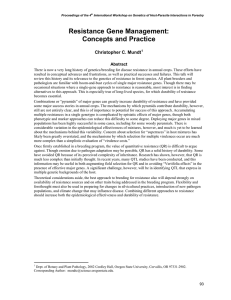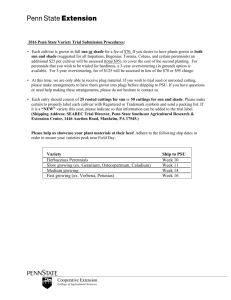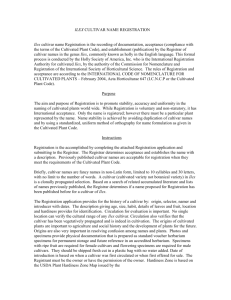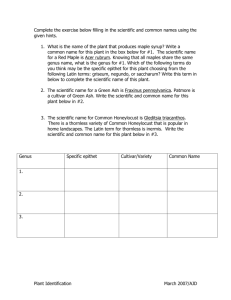Relevance of integrated disease management to resistance durability
advertisement
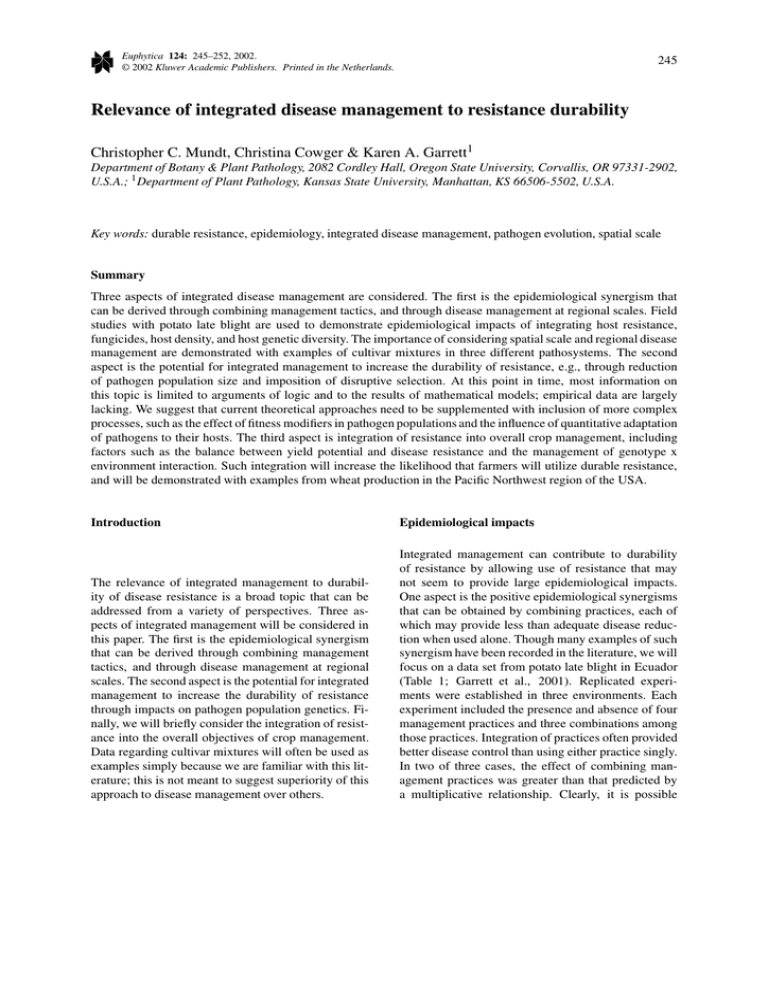
Euphytica 124: 245–252, 2002. © 2002 Kluwer Academic Publishers. Printed in the Netherlands. 245 Relevance of integrated disease management to resistance durability Christopher C. Mundt, Christina Cowger & Karen A. Garrett1 Department of Botany & Plant Pathology, 2082 Cordley Hall, Oregon State University, Corvallis, OR 97331-2902, U.S.A.; 1 Department of Plant Pathology, Kansas State University, Manhattan, KS 66506-5502, U.S.A. Key words: durable resistance, epidemiology, integrated disease management, pathogen evolution, spatial scale Summary Three aspects of integrated disease management are considered. The first is the epidemiological synergism that can be derived through combining management tactics, and through disease management at regional scales. Field studies with potato late blight are used to demonstrate epidemiological impacts of integrating host resistance, fungicides, host density, and host genetic diversity. The importance of considering spatial scale and regional disease management are demonstrated with examples of cultivar mixtures in three different pathosystems. The second aspect is the potential for integrated management to increase the durability of resistance, e.g., through reduction of pathogen population size and imposition of disruptive selection. At this point in time, most information on this topic is limited to arguments of logic and to the results of mathematical models; empirical data are largely lacking. We suggest that current theoretical approaches need to be supplemented with inclusion of more complex processes, such as the effect of fitness modifiers in pathogen populations and the influence of quantitative adaptation of pathogens to their hosts. The third aspect is integration of resistance into overall crop management, including factors such as the balance between yield potential and disease resistance and the management of genotype x environment interaction. Such integration will increase the likelihood that farmers will utilize durable resistance, and will be demonstrated with examples from wheat production in the Pacific Northwest region of the USA. Introduction Epidemiological impacts The relevance of integrated management to durability of disease resistance is a broad topic that can be addressed from a variety of perspectives. Three aspects of integrated management will be considered in this paper. The first is the epidemiological synergism that can be derived through combining management tactics, and through disease management at regional scales. The second aspect is the potential for integrated management to increase the durability of resistance through impacts on pathogen population genetics. Finally, we will briefly consider the integration of resistance into the overall objectives of crop management. Data regarding cultivar mixtures will often be used as examples simply because we are familiar with this literature; this is not meant to suggest superiority of this approach to disease management over others. Integrated management can contribute to durability of resistance by allowing use of resistance that may not seem to provide large epidemiological impacts. One aspect is the positive epidemiological synergisms that can be obtained by combining practices, each of which may provide less than adequate disease reduction when used alone. Though many examples of such synergism have been recorded in the literature, we will focus on a data set from potato late blight in Ecuador (Table 1; Garrett et al., 2001). Replicated experiments were established in three environments. Each experiment included the presence and absence of four management practices and three combinations among those practices. Integration of practices often provided better disease control than using either practice singly. In two of three cases, the effect of combining management practices was greater than that predicted by a multiplicative relationship. Clearly, it is possible 246 Table 1. Area under the disease progress curve (AUDPC) of potato late blight relative to ‘no disease management’ for four management practices and three combinations of practices (adapted from Garrett et al., 2001) AUDPC relative to ‘no disease management’a Management practice Comparison 1: ‘No disease management’ = susceptible cultivar, no fungicide, normal planting density. Weekly fungicide Partial resistance Partial resistance + weekly fungicide Comparison 2: ‘No disease management’ = (0.25 × susceptible pure stand) + (0.75 × partially resistant pure stand), no fungicide, normal planting density. Cultivar mixture (1 susceptible:3 partially resistant) Weekly fungicide Cultivar mixture + weekly fungicide Comparison 3: ‘No disease management’ = (0.25 × susceptible pure stand) + (0.75 × partially resistant pure stand), no fungicide, twice normal planting density. Cultivar mixture (1 susceptible:3 partially resistant) Plant density decreased 50% Cultivar mixture + decreased density 0.56 0.46 0.09 (0.27) 0.97 0.35 0.24 (0.34) 0.94 0.93 0.90 (0.88) a Values in parentheses are expected relative AUDPCs for combined management practices under assumption of a multiplicative relationship between management practices, i.e., relative AUDPC of management practice A × relative AUDPC of management practice B = expected relative AUDPC for the combination of management practices A and B. to attain substantial epidemiological synergism by combining disease practices. An aspect of epidemiological impacts that has received less attention is the effect of spatial scale. For wind-dispersed pathogens in particular, disease severity observed in a given field might depend on management practices deployed on a regional basis. Host plant resistance can be affected by outside sources of inoculum, whether this derives from susceptible treatments within an experiment (Paysour & Fry, 1983) or from inoculum produced in commercial production (Mundt & Brophy, 1988). All types of resistance are affected by outside inoculum, though to different degrees. Major gene resistance may allow higher disease levels in breeding nurseries than in commercial fields, owing to high inoculum loads in nurseries, though expression of the resistance is usually clear in either case (Mundt, unpublished). The quantitative expression of partial resistance can be greatly influenced by interplot interference, though the ranking of genotypes may not be affected (e.g., Parlevliet & van Ommeren, 1975). Cultivar mixtures are highly sensitive to the effects of outside inoculum (Mundt, 1994; Garrett & Mundt, 1999), and interplot interference can sometimes completely mask the effects of diversity on disease progression (Mundt, 1994; Wolfe, 1985). The nature of disease spread may also affect spatial influences on disease management. Earlier theory had suggested that epidemics expand in time and space as a wave of constant velocity (Minogue & Fry, 1983; van den Bosch & Zadoks, 1988). This would imply that differences between managed and unmanaged situations are constant with respect to time and space (Figure 1A). In contrast, Ferrandino (1993) suggested that epidemic velocity should increase in time and space for wind-dispersed pathogens once there is significant dispersal out of the crop canopy. This would result in increasing differences between managed and unmanaged situations as epidemics expand (Figure 1B). The negative aspect of such scale influences is that some management practices may provide less than their maximum effects during early adoption stages. The positive side is that the effect of the practice may increase with expanded adoption, or as other management practices are utilized to provide region-wide management. For example, the potato late blight data shown in Table 1 were derived in a region with con- 247 Figure 1. Theoretical relationship between velocity of epidemics with time or distance for two epidemics increasing at different initial temporal infection rates (r) under the assumptions of A. Constant velocity (v) and v = r/b, where b is the slope of the disease gradient. B. Dispersive epidemic wave (Ferrandino, 1993) with v = rx/b, where x is distance, and assuming feedback among parameters over time and space. to less than 10%, while fungicide use decreased about three-fold. Similar reductions of mildew severity did not occur in adjacent countries, where diversification was not practiced. In addition, recent experiments were conducted in China on areas of 812 ha in 1998 and 3342 ha in 2000. All rice fields in entire townships were planted to mixtures, and replicated pure stand controls were monitored in each township. The severity of blast (caused by Magnaporthe grisea) on the susceptible, glutinous rice cultivars was reduced by an average of 94% when deployed within fields of more resistant cultivars (Zhu et al., 2000). Regional effects, however, also raise the issue of tradeoffs between epidemiological impacts and durability of resistance. Large-scale deployment of a single crop genotype or mixture will of course place greater selective pressure on the pathogen to adapt. It thus would be prudent to counter this effect by deploying cultivars with different sources of partial resistance, growing mixtures containing different host genotypes, developing ‘pyramids’ with different combinations of resistance genes, and combining host plant resistance with other management practices. Such safeguards will occur naturally in some cases, since the same cultivar or mixture will not necessarily be well adapted agronomically to all environments within a given region. Effects on durability of resistance tinuous potato production and large amounts of aerial inoculum, and the cultivar mixture that was studied reduced late blight severity by only 4% when averaged over the three sites. However, the experiment at the site most distant (15 km) from other potato fields showed a reduction of 23%. One cannot be sure that this difference was caused by effects of outside inoculum, though this view is supported by larger mixture effects in the more seasonal potato production areas of Peru (Garrett et al., in preparation) and in the Willamette Valley of Oregon, USA, where reductions of 36% were obtained in two different seasons (Garrett & Mundt, 2000). Stronger support for the effect of regional management comes from the former German Democratic Republic (Wolfe, 1992). In the 1980s, barley (Hordeum vulgare) cultivar mixtures gradually expanded from 0 to 92% of the total barley area. Correspondingly, the severity of powdery mildew (caused by Erysiphe graminis) declined from greater than 50% It seems logical that integrated management has the potential to increase the durability of resistance as compared to using the same resistance in a nonintegrated manner. To the extent that integration reduces epidemic development, pathogen population sizes will be reduced. This would thus decrease the probability that a resistance-breaking genotype will be present in the pathogen population. In addition, combining management practices may present the pathogen population with multiple barriers to overcome. Beyond such common-sense statements of logic, however, we have very little information available on this topic. There is some anecdotal information regarding increased durability of major genes for resistance when deployed in multiline cultivars (Mundt, 1994). However, experimental data with appropriate controls are non-existent, as pathogen adaptation involves infrequent events that may require large spatial and temporal scales of study. 248 Given the difficulty of studying resistance durability empirically, there has correspondingly been a much stronger emphasis on development of mathematical models. For example, models have been used to compare the impacts of deploying race-specific resistance genes in mixtures, pyramids, or in rotation over time (Kiyosawa, 1989; Leonard & Czochor, 1980; Marshall, 1989), though no strong consensus has evolved from the output of these models. Nearly all models of plant pathogen evolution assume a genetic cost associated with virulence. Unfortunately, such costs are extremely difficult to measure empirically (Leonard, 1977; Parlevliet, 1981; Vanderplank, 1975) and a review of the literature suggests that there is little evidence to support the existence of such costs (Parlevliet, 1981) as a general phenomenon. There certainly may be specific virulence alleles for which costs occur, of course. Though more research is needed to evaluate the importance of genetic costs, there may be other processes that are in fact more important. Parlevliet (1981) proposed that virulence evolution involves a two-step process of mutation to virulence, which is often associated with a fitness reduction, followed by selection for fitness modifiers that ameliorate fitness losses. This proposition is supported by more recent studies of non-plant pathogenic bacteria, where fitness modifiers have been identified that can ameliorate initial fitness costs associated with antibiotic resistance (e.g., Cohan et al., 1994; Levin et al., 2000; Morrell, 1997). If similar processes occur commonly for plant pathogen virulence, as suggested by Parlevliet (1981), then resistance gene management strategies may need to account for a more complex process of selection for both virulence alleles and fitness modifiers, rather than the traditional view of considering fitness costs to be static. Other quantitative genetic processes may also prove critical to predicting resistance durability. Quantitative adaptation of pathogen populations to host genetic background can be detected in greenhouse tests, provided that the starting population is relatively diverse (summarized in Mundt et al., 1999b). It is more difficult, however, to determine whether this is a significant phenomenon in the field. We have used Mycosphaerella graminicola in the Willamette Valley of Oregon as a model system for studying durability of resistance in the field, as conditions allow the pathogen to adapt to host plant resistance very rapidly. The environment is highly conducive to reproduction of M. graminicola (Mundt et al., 1999b). Further, Table 2. Percent disease severity caused by Mycosphaerella graminicola populations derived from single wheat cultivars and cultivar mixtures (Mundt et al., 1999a) Source cultivars % Severity caused by isolates from Mixturea Pure Standsb Cashup/Stephens Cashup/W-301 Madsen/Stephens Madsen/W-301 Mean 10.8 6.6 9.5 9.3 9.1 13.4 9.0 15.9 11.6 12.4 a Mean disease severity for populations derived from a given mixture when tested separately on each of the component cultivars. For example, populations collected from the Cashup/Stephens mixture in the field were tested separately on Cashup and Stephens in the greenhouse. b Mean disease severity for populations derived from the component pure stands and tested on the same cultivar. For example, to compare with populations derived from the Cashup/Stephens mixture, populations collected from pure stands of Cashup in the field were tested on Cashup in the greenhouse and populations derived from pure stands of Stephens in the field were tested on Stephens in the greenhouse. an active sexual stage and large minimum population size result in a very high degree of pathogen variation (Boeger et al., 1993; Chen et al., 1994; McDonald et al., 1996). Greenhouse analyses of field collections indicate that the pathogen is able to adapt to both qualitative (Cowger et al., 2000) and partial (Ahmed et al., 1995; 1996) resistance. ‘Stephens’ had been the dominant wheat cultivar in this area since the early 1980s, but is highly susceptible to M. graminicola. The only attempt at deploying major gene resistance was with the cultivar ‘Gene’, which likely contains the resistance gene Stb4 (Kronstad et al., 1994; Somasco et al., 1996). Release of Gene resulted in a dramatic failure of resistance before this highly desired cultivar expanded beyond 15% of the total wheat area (Figs. 2 and 3). More disturbing has been the fact that the partial resistance of the cultivar ‘Madsen’ has also eroded substantially over time (Figure 3). Data shown in Figure 3 should not be interpreted as a substantially negative prognosis for the durability of partial resistance, for several reasons. First, erosion was slower for partial resistance than for major gene resistance against M. graminicola (Figure 3). Second, erosion of partial resistance may be of little or no consequence for pathogens with less variability than M. graminicola, for example those that are asexual and/or experience frequent genetic bottlenecks. Finally, quantitative adaptation can actually be 249 Figure 2. Change over years in the percentage of winter wheat area sown to three cultivars (Gene, Madsen, and Stephens) in the Willamette Valley of Oregon, USA. used to more effectively manage pathogens. For example, Chin & Wolfe (1982) provided data indicating that quantitative adaptation to host genetic background may have prevented complex races of E. graminis from dominating in barley cultivar mixtures. Similarly, computer simulations suggest that disruptive selection caused by such adaptation may be one of the factors more likely to counter selection for pathogen complexity in mixtures (Lannou & Mundt, 1996; 1997). Diversifying sources of partial resistance, on a field or regional basis, might also slow pathogen adaptation. For example, populations of M. graminicola sampled from mixtures of a susceptible and a partially resistant wheat cultivar were all less fit than populations derived from the same cultivars grown in pure stand (Table 2). In summary, predicting the effects of integrated management on resistance durability will likely require increased consideration of quantitative interactions, as opposed to the traditional view that there are static costs associated with virulence. Overall crop management In addition to disease resistance, a successful cultivar must also incorporate a complex suite of agronomic and quality characteristics. The possibility of simultaneously combining a multitude of traits into a single plant genotype may seem daunting at first, especially when inheritance is quantitative. Practical experience is more encouraging, however. For example, Parlevliet (1989) demonstrated rapid, simultaneous selection for both partial resistance to leaf rust (caused by Puccinia hordei) and yield of barley. In addition, it is important to remember that real-world breeding programs do not invest equal effort in selecting for all desired traits at a given point in time. Wheat breeders in the Pacific Northwest region of the USA deal successfully with about a dozen potentially important diseases, as well as diverse environments with yield potentials ranging from 2 to 12 metric tonnes per hectare. As with many breeding programs, maintaining a high frequency of parents with resistance to important diseases greatly reduces the breeding effort. For example, yellow rust (caused by Puccinia striiformis) resulted in substantial losses in the 1950s and 250 Figure 3. Change over years in the severity of Septoria tritici leaf blotch for wheat cultivars with major gene resistance (Gene) and partial resistance (Madsen) in the Willamette Valley of Oregon, USA. Severity ratings of Gene and Madsen are expressed relative to that of the susceptible cultivar Stephens in each year, so as to normalize for differences in environment among years. Table 3. Percent of tillers with early maturity (whiteheads) caused by Cephalosporium gramineum and yield of two cultivars and their 1:1 mixture at two locations (Condon and Wasco) in Oregon, USA Cultivar Madsen Stephens Madsen/Stephens LSD (0.05) % Whiteheads Condon Wasco 8.8 34.4 18.6 6.2 3.3 46.3 26.3 5.2 Relative yielda Condon Wasco 92 99 100 10 100 91 100 8 a Grain yield of each treatment divided by that of the mixture at each location. 1960s, but has subsequently been controlled through use of high-temperature, adult-plant resistance (Line & Chen, 1995). Given the high frequency of parents with such resistance in current breeding programs, selection often entails merely being on guard for the rare susceptible genotype, thus allowing breeders to devote more effort to other goals. All desired traits are never incorporated into a single genotype, of course, and crop management can sometimes be used to overcome shortcomings of a given cultivar, e.g., through manipulating rotations, fertility management, tillage, and sowing dates. Cultivar mixtures can also be used to manage shortcomings of individual cultivars. For example, in Oregon, USA the cultivar Stephens has outstanding and consistent yield potential, but can suffer substantial losses from Cephalosporium stripe (caused by Cephalosporium gramineum) in some locations. In contrast, the cultivar ‘Madsen’ possesses moderate resistance against this and many other diseases, but some growers have found that its yield varies substantially among years. In areas of moderate disease pressure, a mixture of these two cultivars will often yield equal to the best yielding single cultivar (Table 3). Given that cultivar mixtures do not substantially reduce the severity of Cephalosporium stripe within a season (Table 3), this yield benefit is likely due to compensatory responses between the cultivars in mixture. In areas where Cephalosporium stripe is more severe, mixtures of two moderately resistant cultivars are commonly grown so as to combine disease protection and yield stability (Mundt, 2001). 251 Conclusions Integrated management can contribute to the successful deployment of durable resistance. Epidemiological advantages can be derived by combining management practices, and through disease management on a regional scale. Logic suggests that integrated management should slow pathogen adaptation to resistance, though data are greatly lacking. Predicting durability of resistance may require increased emphasis on more complex processes, such as selection for fitness modifiers and quantitative adaptation of pathogens to their hosts. To make the most effective use of durable resistance, one must also consider overall crop management, including desired yields, crop quality, yield stability, and resistance to multiple diseases. Observation suggests that it may be more feasible to address such diverse needs than has sometimes been postulated. References Ahmed, H.U., C.C. Mundt & S.M. Coakley, 1995. Host-pathogen relationship of geographically diverse isolates of Septoria tritici and wheat cultivars. Plant Pathol 44: 838–847. Ahmed, H.U., C.C. Mundt, M.E. Hoffer & S.M. Coakley, 1996. Selective influence of wheat cultivars on pathogenicity of Mycosphaerella graminicola (anamorph Septoria tritici). Phytopathology 86: 454–458. Boeger, J.M., R.-S. Chen, & B.A. McDonald, 1993. Gene flow between geographic populations of Mycosphaerella graminicola (anamorph Septoria tritici) detected with restriction fragment length polymorphism markers. Phytopathology 83: 1148–1154. Chen, R.-S., J.M. Boeger & B.A. McDonald, 1994. Genetic stability in a population of a plant pathogenic fungus over time. Mol Ecol 3: 209–218. Chin, K.M. & M.S Wolfe, 1984. Selection on Erysiphe graminis in pure and mixed stands of barley. Plant Pathol 33: 535–546. Cohan, F.M., E.C. King & P. Zawadzki, 1994. Amelioration of the deleterious pleiotropic effects of an adaptive mutation in Bacillus subtilis. Evolution 48: 81–95. Cowger, C., M.E. Hoffer & C.C. Mundt, 2000. Specific adaptation by Mycosphaerella graminicola to a resistant wheat cultivar. Plant Pathol 49: 445–451. Ferrandino, F.J., 1993. Dispersive epidemic waves: I. Focus expansion within a linear planting. Phytopathology 83: 795–802. Garrett, K.A. & C.C. Mundt, 1999. Epidemiology in mixed host populations. Phytopathology 89: 984–990. Garrett, K.A. & C.C. Mundt, 2000. Host diversity can reduce potato late blight severity for focal and general patterns of primary inoculum. Phytopathology 90: 1307–1312. Garrett, K.A., R.J. Nelson, C.C. Mundt, G. Chacon, R.E. Jaramillo & G.A. Forbes, 2001. The effects of host diversity and other management components on epidemics of potato late blight in the humid highland tropics. Phytopathology 91: in press. Kiyosawa, S., 1989. Breakdown of blast resistance in relation to general strategies of resistance gene deployment to prolong effectiveness of resistance in plants. In: K.J. Leonard & W.E. Fry (Eds.), Plant Disease Epidemiology, Vol. 2, pp. 251–283. McGraw-Hill, New York. Kronstad, W.E., M.F. Kolding, P.K. Zwer & R.S. Karow, 1994. Registration of ‘Gene’ wheat. Crop Sci 34: 538. Lannou, C. & C.C. Mundt, 1996. Evolution of a pathogen population in host mixtures. I. Study of the simple race-complex race equilibrium. Plant Pathol 45: 440–453. Lannou, C. & C.C. Mundt, 1997. Evolution of a pathogen population in host mixtures: Rate of emergence of complex races. Theor Appl Genet 94: 991–999. Leonard, K.J., 1977. Selection pressures and plant pathogens. Ann NY Acad Sci 277: 207–222. Leonard, K.J. & R.J. Czochor, 1980. Theory of genetic interactions among populations of plants and their pathogens. Annu Rev Phytopathol 18: 237–258. Levin, B.R., P. Veronique & N. Walker, 2000. Compensatory mutations, antibiotic resistance and the population genetics of adaptive evolution in bacteria. Genetics 154: 985–997. Line, R.F. & X. Chen, 1995. Successes in breeding for and managing durable resistance in wheat rusts. Plant Dis 12: 1254–1255. Marshall, D.R., 1989. Modeling the effects of multiline varieties on the population genetics of plant pathogens, In: K.J. Leonard & W.E. Fry (Eds.), Plant Disease Epidemiology, Vol. 2, pp. 284– 317. McGraw-Hill, New York. McDonald, B.A., C.C. Mundt & R.-S. Chen, 1996. The role of selection on the genetic structure of pathogen populations: Evidence from field experiments with Mycosphaerella graminicola on wheat. Euphytica 92: 73–80. Minogue, K.P. & W.E. Fry, 1983. Models for the spread of disease: Model description. Phytopathology 73: 1168–1173. Morrell, V., 1997. Antibiotic resistance: Road of no return. Science 278: 575–576. Mundt, C.C., 1994. Use of host genetic diversity to control cereal diseases: Implications for rice blast, In: S.A. Leong, R.S. Zeigler & P.S. Teng (Eds.), Rice Blast Disease, pp. 293–307. CAB International, Wallingford (UK). Mundt, C.C., 2002. Performance of wheat cultivars and cultivar mixtures in the presence of Cephalosporium stripe. Crop Prot 21: 91–99 Mundt, C.C. & L.S. Brophy, 1988. Influence of number of host genotype units on the effectiveness of host mixtures for disease control: A modeling approach. Phytopathology 78: 1087–1094. Mundt, C.C., C. Cowger & M.E. Hoffer, 1999a. Disease management using variety mixtures. In: M. van Ginkel, A. McNab & J. Krupinsky (Eds.), Septoria and Stagonospora Diseases of Cereals: A Compilation of Global Research, pp. 111–116. CIMMYT, Mexico, D.F. Mundt, C.C., M.E. Hoffer, H.U. Ahmed, S.M. Coakley, J.A. DiLeone & C. Cowger, 1999b. Population genetics and host resistance, In: J.A. Lucas, P. Bowyer & H.M. Anderson (Eds.), Septoria on Cereals: A Study of Pathosystems, pp. 115–130. CAB International, Wallingford (UK). Parlevliet, J.E., 1981. Stabilizing selection in crop patho-systems: An empty concept or a reality? Euphytica 30: 259–269. Parlevliet, J.E., 1989. Identification and evaluation of quantitative resistance, In: K.J. Leonard & W.E. Fry (Eds.), Plant Disease Epidemiology, Vol. 2, pp. 215–248. McGraw-Hill, New York. Parlevliet, J.E. & A. van Ommeren, 1975. Partial resistance of barley to leaf rust, Puccinia hordei. II. Relationship between field trials, micro plot tests and latent period. Euphytica 24: 293–303. Paysour, R.E. & W.E. Fry, 1983. Interplot interference: A model for planning field experiments with aerially disseminated pathogens. Phytopathology 73: 1014–1020. 252 Somasco, O.A., C.O. Qualset & D.G. Gilchrist, 1996. Single-gene resistance to Septoria tritici blotch in the spring wheat cultivar ‘Tadinia’. Zeitschrift Pflanzen 115: 261–267. van den Bosch, F., J.C. Zadoks & J.A.J. Metz, 1988. Focus expansion in plant disease. I. The constant rate of focus expansion. Phytopathology 78: 54–58. Vanderplank, J.E., 1975. Principles of Plant Infection. Academic Press, New York. Wolfe, M.S., 1985. The current status and prospects of multiline cultivars and variety mixtures for disease resistance. Annu Rev Phytopathol 23: 251–273. Wolfe, M.S., 1992. Barley diseases: Maintaining the value of our varieties, In: L. Munck (Ed.), Barley Genetics VI, pp. 1055–1067. Munksgaard International Publishers, Copenhagen. Zhu, Y., H. Chen, J. Fan, Y. Wang, Y. Li, J. Chen, J.-X. Fan, S. Yang, L. Hu, H. Leung, T.W. Mew, P.S. Teng, Z. Wang & C.C. Mundt, 2000. Genetic diversity and disease control in rice. Nature 406: 718–722.
